Leading Change: Strategies, Drivers, and Impact on Organizations
VerifiedAdded on 2020/06/04
|14
|3980
|117
Report
AI Summary
This report provides a detailed analysis of leading change within organizations, focusing on the strategies and impacts of change on organizational operations and leadership. It begins by comparing two retail organizations, Hennes & Mauritz (H&M) and Marks & Spencer (M&S), evaluating how changes in technology and market dynamics necessitate adaptations in their strategies and operations. The report examines the influence of internal and external drivers on leadership, team dynamics, and individual behaviors, identifying factors such as mission statements, organizational structures, customer satisfaction, political and economic influences, socio-cultural trends, and technological advancements. Furthermore, it explores measures to mitigate the adverse effects of change, including strategies for managing workplace demographics, addressing globalization, and fostering effective communication to minimize resistance to change. The report highlights the critical role of leaders in navigating organizational transformations, emphasizing the need for proactive planning, clear communication, and employee engagement to ensure successful implementation and adaptation to evolving market conditions.
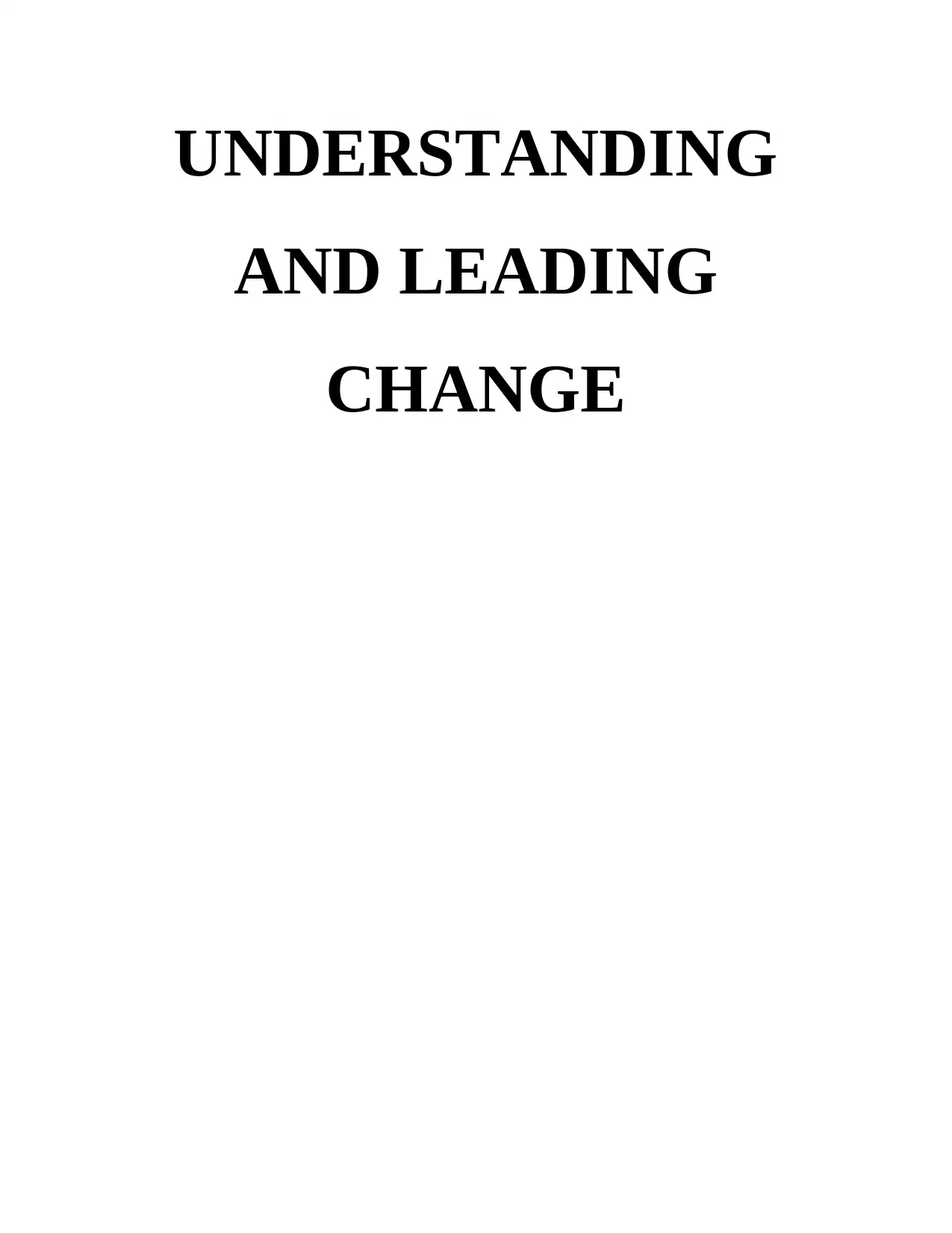
UNDERSTANDING
AND LEADING
CHANGE
AND LEADING
CHANGE
Paraphrase This Document
Need a fresh take? Get an instant paraphrase of this document with our AI Paraphraser

Table of Contents
INTRODUCTION...........................................................................................................................1
TASK 1............................................................................................................................................1
P1 Evaluating the impact of changes on strategy and operations by comparing two
organisation............................................................................................................................1
P2 Impact of internal and external drivers on leadership, team and behaviours of individual
within an organisation............................................................................................................2
P3 Measures used to minimise the adverse effect of change on behaviour of organisations.5
TASK 2............................................................................................................................................6
P4 The barriers of changes as well as its impact on decision making of leadership..............6
P5 Different approaches of leadership in dealing with changes in organisation....................7
CONCLUSIONS..............................................................................................................................8
REFERENCES..............................................................................................................................10
INTRODUCTION...........................................................................................................................1
TASK 1............................................................................................................................................1
P1 Evaluating the impact of changes on strategy and operations by comparing two
organisation............................................................................................................................1
P2 Impact of internal and external drivers on leadership, team and behaviours of individual
within an organisation............................................................................................................2
P3 Measures used to minimise the adverse effect of change on behaviour of organisations.5
TASK 2............................................................................................................................................6
P4 The barriers of changes as well as its impact on decision making of leadership..............6
P5 Different approaches of leadership in dealing with changes in organisation....................7
CONCLUSIONS..............................................................................................................................8
REFERENCES..............................................................................................................................10

⊘ This is a preview!⊘
Do you want full access?
Subscribe today to unlock all pages.

Trusted by 1+ million students worldwide
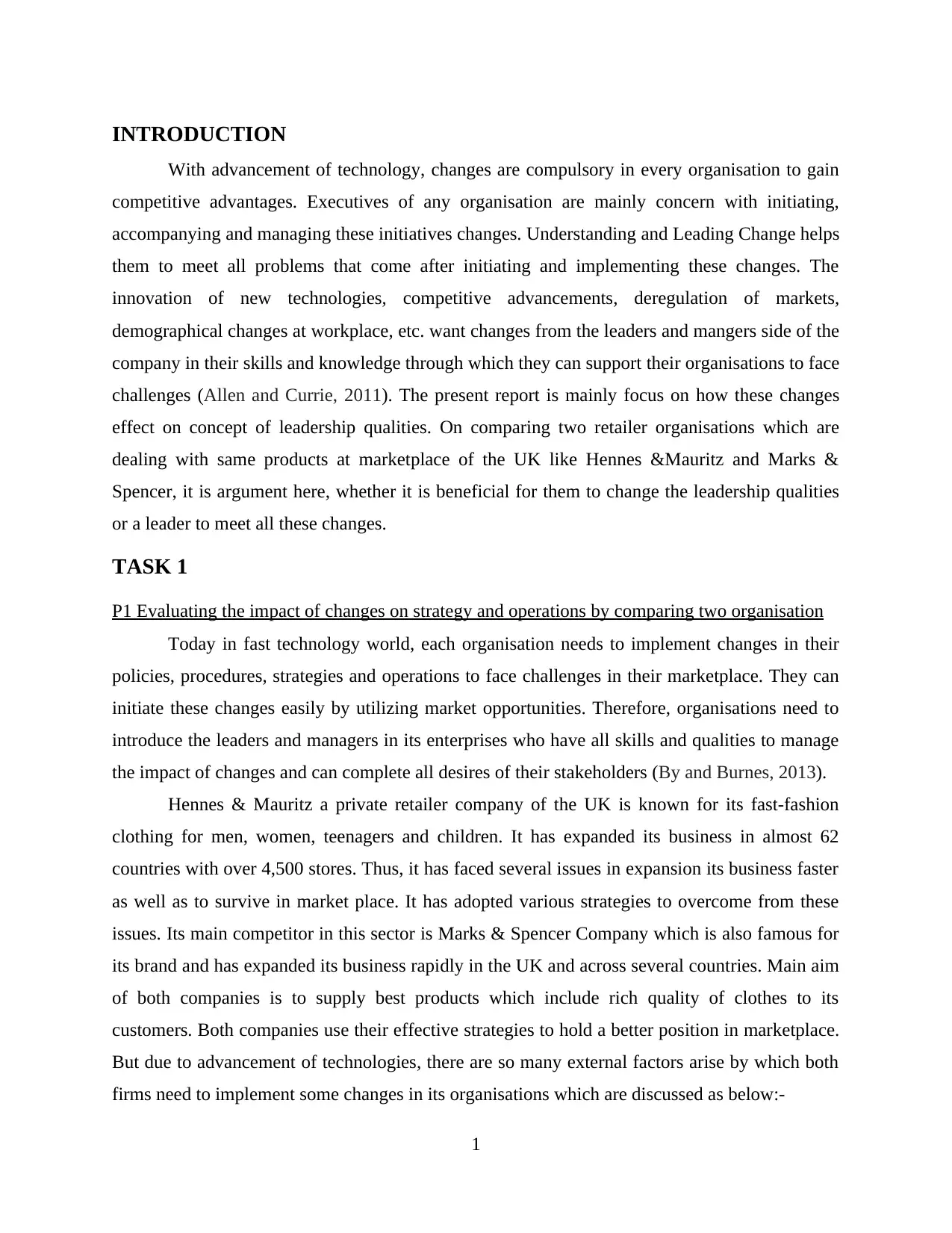
INTRODUCTION
With advancement of technology, changes are compulsory in every organisation to gain
competitive advantages. Executives of any organisation are mainly concern with initiating,
accompanying and managing these initiatives changes. Understanding and Leading Change helps
them to meet all problems that come after initiating and implementing these changes. The
innovation of new technologies, competitive advancements, deregulation of markets,
demographical changes at workplace, etc. want changes from the leaders and mangers side of the
company in their skills and knowledge through which they can support their organisations to face
challenges (Allen and Currie, 2011). The present report is mainly focus on how these changes
effect on concept of leadership qualities. On comparing two retailer organisations which are
dealing with same products at marketplace of the UK like Hennes &Mauritz and Marks &
Spencer, it is argument here, whether it is beneficial for them to change the leadership qualities
or a leader to meet all these changes.
TASK 1
P1 Evaluating the impact of changes on strategy and operations by comparing two organisation
Today in fast technology world, each organisation needs to implement changes in their
policies, procedures, strategies and operations to face challenges in their marketplace. They can
initiate these changes easily by utilizing market opportunities. Therefore, organisations need to
introduce the leaders and managers in its enterprises who have all skills and qualities to manage
the impact of changes and can complete all desires of their stakeholders (By and Burnes, 2013).
Hennes & Mauritz a private retailer company of the UK is known for its fast-fashion
clothing for men, women, teenagers and children. It has expanded its business in almost 62
countries with over 4,500 stores. Thus, it has faced several issues in expansion its business faster
as well as to survive in market place. It has adopted various strategies to overcome from these
issues. Its main competitor in this sector is Marks & Spencer Company which is also famous for
its brand and has expanded its business rapidly in the UK and across several countries. Main aim
of both companies is to supply best products which include rich quality of clothes to its
customers. Both companies use their effective strategies to hold a better position in marketplace.
But due to advancement of technologies, there are so many external factors arise by which both
firms need to implement some changes in its organisations which are discussed as below:-
1
With advancement of technology, changes are compulsory in every organisation to gain
competitive advantages. Executives of any organisation are mainly concern with initiating,
accompanying and managing these initiatives changes. Understanding and Leading Change helps
them to meet all problems that come after initiating and implementing these changes. The
innovation of new technologies, competitive advancements, deregulation of markets,
demographical changes at workplace, etc. want changes from the leaders and mangers side of the
company in their skills and knowledge through which they can support their organisations to face
challenges (Allen and Currie, 2011). The present report is mainly focus on how these changes
effect on concept of leadership qualities. On comparing two retailer organisations which are
dealing with same products at marketplace of the UK like Hennes &Mauritz and Marks &
Spencer, it is argument here, whether it is beneficial for them to change the leadership qualities
or a leader to meet all these changes.
TASK 1
P1 Evaluating the impact of changes on strategy and operations by comparing two organisation
Today in fast technology world, each organisation needs to implement changes in their
policies, procedures, strategies and operations to face challenges in their marketplace. They can
initiate these changes easily by utilizing market opportunities. Therefore, organisations need to
introduce the leaders and managers in its enterprises who have all skills and qualities to manage
the impact of changes and can complete all desires of their stakeholders (By and Burnes, 2013).
Hennes & Mauritz a private retailer company of the UK is known for its fast-fashion
clothing for men, women, teenagers and children. It has expanded its business in almost 62
countries with over 4,500 stores. Thus, it has faced several issues in expansion its business faster
as well as to survive in market place. It has adopted various strategies to overcome from these
issues. Its main competitor in this sector is Marks & Spencer Company which is also famous for
its brand and has expanded its business rapidly in the UK and across several countries. Main aim
of both companies is to supply best products which include rich quality of clothes to its
customers. Both companies use their effective strategies to hold a better position in marketplace.
But due to advancement of technologies, there are so many external factors arise by which both
firms need to implement some changes in its organisations which are discussed as below:-
1
Paraphrase This Document
Need a fresh take? Get an instant paraphrase of this document with our AI Paraphraser
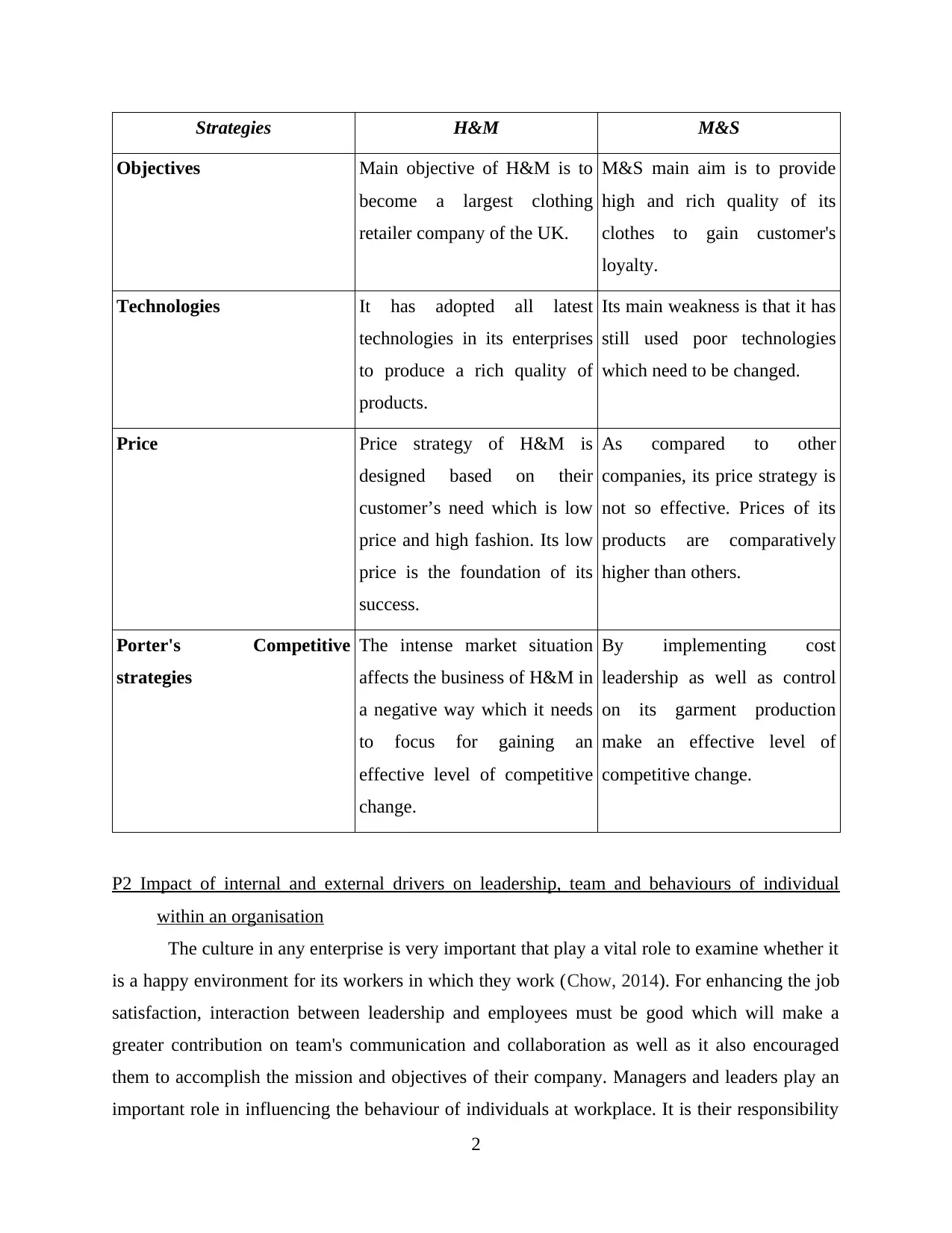
Strategies H&M M&S
Objectives Main objective of H&M is to
become a largest clothing
retailer company of the UK.
M&S main aim is to provide
high and rich quality of its
clothes to gain customer's
loyalty.
Technologies It has adopted all latest
technologies in its enterprises
to produce a rich quality of
products.
Its main weakness is that it has
still used poor technologies
which need to be changed.
Price Price strategy of H&M is
designed based on their
customer’s need which is low
price and high fashion. Its low
price is the foundation of its
success.
As compared to other
companies, its price strategy is
not so effective. Prices of its
products are comparatively
higher than others.
Porter's Competitive
strategies
The intense market situation
affects the business of H&M in
a negative way which it needs
to focus for gaining an
effective level of competitive
change.
By implementing cost
leadership as well as control
on its garment production
make an effective level of
competitive change.
P2 Impact of internal and external drivers on leadership, team and behaviours of individual
within an organisation
The culture in any enterprise is very important that play a vital role to examine whether it
is a happy environment for its workers in which they work (Chow, 2014). For enhancing the job
satisfaction, interaction between leadership and employees must be good which will make a
greater contribution on team's communication and collaboration as well as it also encouraged
them to accomplish the mission and objectives of their company. Managers and leaders play an
important role in influencing the behaviour of individuals at workplace. It is their responsibility
2
Objectives Main objective of H&M is to
become a largest clothing
retailer company of the UK.
M&S main aim is to provide
high and rich quality of its
clothes to gain customer's
loyalty.
Technologies It has adopted all latest
technologies in its enterprises
to produce a rich quality of
products.
Its main weakness is that it has
still used poor technologies
which need to be changed.
Price Price strategy of H&M is
designed based on their
customer’s need which is low
price and high fashion. Its low
price is the foundation of its
success.
As compared to other
companies, its price strategy is
not so effective. Prices of its
products are comparatively
higher than others.
Porter's Competitive
strategies
The intense market situation
affects the business of H&M in
a negative way which it needs
to focus for gaining an
effective level of competitive
change.
By implementing cost
leadership as well as control
on its garment production
make an effective level of
competitive change.
P2 Impact of internal and external drivers on leadership, team and behaviours of individual
within an organisation
The culture in any enterprise is very important that play a vital role to examine whether it
is a happy environment for its workers in which they work (Chow, 2014). For enhancing the job
satisfaction, interaction between leadership and employees must be good which will make a
greater contribution on team's communication and collaboration as well as it also encouraged
them to accomplish the mission and objectives of their company. Managers and leaders play an
important role in influencing the behaviour of individuals at workplace. It is their responsibility
2
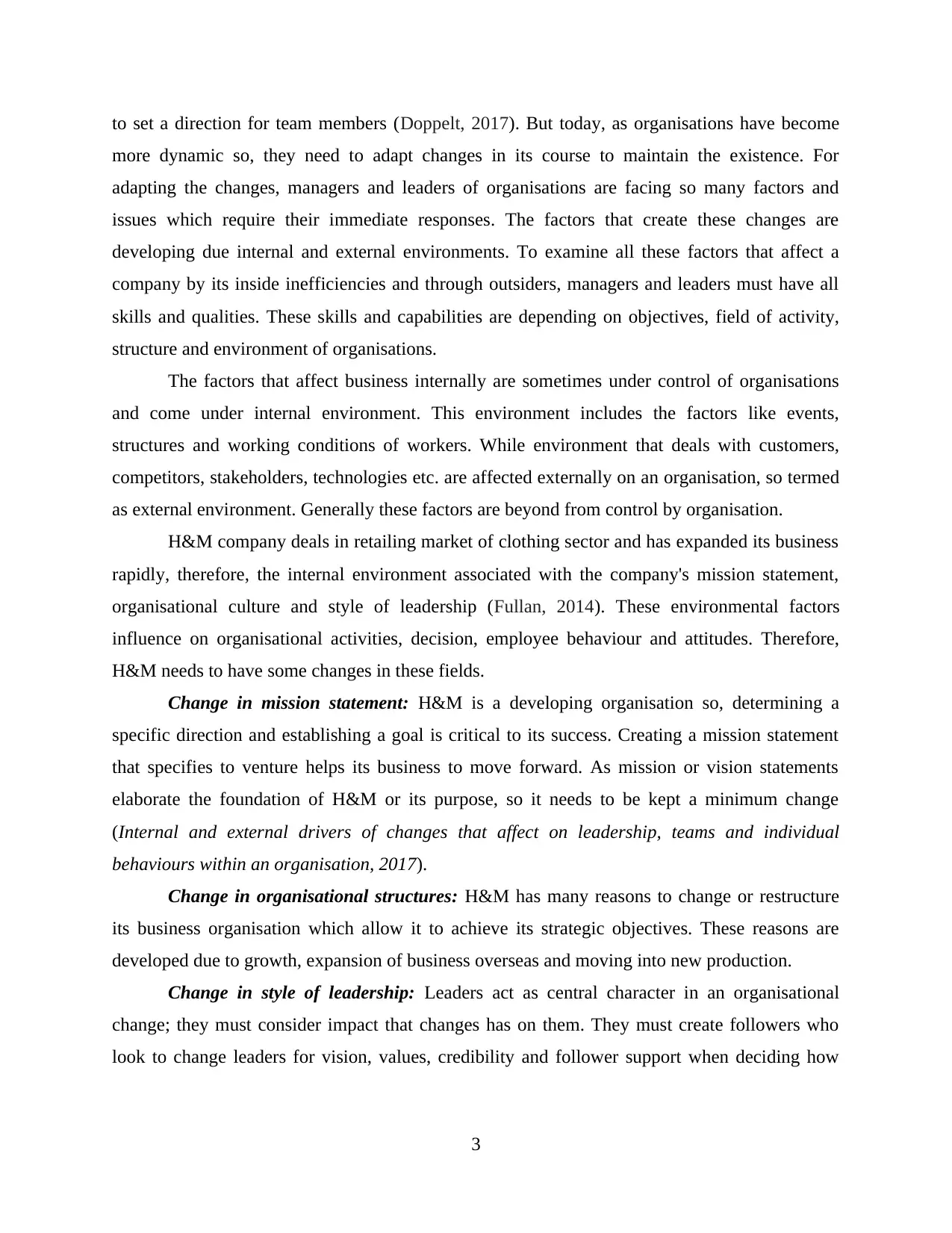
to set a direction for team members (Doppelt, 2017). But today, as organisations have become
more dynamic so, they need to adapt changes in its course to maintain the existence. For
adapting the changes, managers and leaders of organisations are facing so many factors and
issues which require their immediate responses. The factors that create these changes are
developing due internal and external environments. To examine all these factors that affect a
company by its inside inefficiencies and through outsiders, managers and leaders must have all
skills and qualities. These skills and capabilities are depending on objectives, field of activity,
structure and environment of organisations.
The factors that affect business internally are sometimes under control of organisations
and come under internal environment. This environment includes the factors like events,
structures and working conditions of workers. While environment that deals with customers,
competitors, stakeholders, technologies etc. are affected externally on an organisation, so termed
as external environment. Generally these factors are beyond from control by organisation.
H&M company deals in retailing market of clothing sector and has expanded its business
rapidly, therefore, the internal environment associated with the company's mission statement,
organisational culture and style of leadership (Fullan, 2014). These environmental factors
influence on organisational activities, decision, employee behaviour and attitudes. Therefore,
H&M needs to have some changes in these fields.
Change in mission statement: H&M is a developing organisation so, determining a
specific direction and establishing a goal is critical to its success. Creating a mission statement
that specifies to venture helps its business to move forward. As mission or vision statements
elaborate the foundation of H&M or its purpose, so it needs to be kept a minimum change
(Internal and external drivers of changes that affect on leadership, teams and individual
behaviours within an organisation, 2017).
Change in organisational structures: H&M has many reasons to change or restructure
its business organisation which allow it to achieve its strategic objectives. These reasons are
developed due to growth, expansion of business overseas and moving into new production.
Change in style of leadership: Leaders act as central character in an organisational
change; they must consider impact that changes has on them. They must create followers who
look to change leaders for vision, values, credibility and follower support when deciding how
3
more dynamic so, they need to adapt changes in its course to maintain the existence. For
adapting the changes, managers and leaders of organisations are facing so many factors and
issues which require their immediate responses. The factors that create these changes are
developing due internal and external environments. To examine all these factors that affect a
company by its inside inefficiencies and through outsiders, managers and leaders must have all
skills and qualities. These skills and capabilities are depending on objectives, field of activity,
structure and environment of organisations.
The factors that affect business internally are sometimes under control of organisations
and come under internal environment. This environment includes the factors like events,
structures and working conditions of workers. While environment that deals with customers,
competitors, stakeholders, technologies etc. are affected externally on an organisation, so termed
as external environment. Generally these factors are beyond from control by organisation.
H&M company deals in retailing market of clothing sector and has expanded its business
rapidly, therefore, the internal environment associated with the company's mission statement,
organisational culture and style of leadership (Fullan, 2014). These environmental factors
influence on organisational activities, decision, employee behaviour and attitudes. Therefore,
H&M needs to have some changes in these fields.
Change in mission statement: H&M is a developing organisation so, determining a
specific direction and establishing a goal is critical to its success. Creating a mission statement
that specifies to venture helps its business to move forward. As mission or vision statements
elaborate the foundation of H&M or its purpose, so it needs to be kept a minimum change
(Internal and external drivers of changes that affect on leadership, teams and individual
behaviours within an organisation, 2017).
Change in organisational structures: H&M has many reasons to change or restructure
its business organisation which allow it to achieve its strategic objectives. These reasons are
developed due to growth, expansion of business overseas and moving into new production.
Change in style of leadership: Leaders act as central character in an organisational
change; they must consider impact that changes has on them. They must create followers who
look to change leaders for vision, values, credibility and follower support when deciding how
3
⊘ This is a preview!⊘
Do you want full access?
Subscribe today to unlock all pages.

Trusted by 1+ million students worldwide

hard they will work to support a change initiative. Insight of leaders, some drivers of change in
the fashion industry like H&M are-
Rebranding sustainability
Create a level playing field
Business setting bold goals
Engage a wider audience
Engage the next generation
Collaboration
Harness the power industry
Harness consumer audiences
The external driving forces that affect on leadership qualities of H&M are described as:-
Customer's loyalty and satisfaction: In any organisation, its strategies of business
operations are totally dependent on satisfaction level of its customers (Gonzales and Pacheco,
2012). The taste, preferences and satisfaction of customers affect the whole production system of
all type of organisations including retailing sector like H&M. So it is the main factor that
influences role of leaders and their leadership.
Political influence: Political legislation of any country affects directly the business
operational strategies of its companies. As H&M has expanded its business in 62 countries so it
also affected by legislations of these countries which is subjected to custom duties.
Economic: Rising labour cost has affected the production of H&M and other retailer
companies. Also the recession period of country causes lack of confidence amongst its
consumers.
Socio-cultural: Customer's lifestyle, taste, social interaction and rising interest in green
issues are some social factors that affected on H&M.
Technological: All retailer companies including H&M has adopted new ways of selling
their products through online shopping and e-commerce.
Environmental: Use of renewable resources, energy efficiency and reducing wastage are
some environmental changes adopted by H&M.
Therefore, on examining these changes leaders of H&M try to adapt as fast as they can
and implement them in its organisation (Hague, Gill and Begikhani, 2013).
4
the fashion industry like H&M are-
Rebranding sustainability
Create a level playing field
Business setting bold goals
Engage a wider audience
Engage the next generation
Collaboration
Harness the power industry
Harness consumer audiences
The external driving forces that affect on leadership qualities of H&M are described as:-
Customer's loyalty and satisfaction: In any organisation, its strategies of business
operations are totally dependent on satisfaction level of its customers (Gonzales and Pacheco,
2012). The taste, preferences and satisfaction of customers affect the whole production system of
all type of organisations including retailing sector like H&M. So it is the main factor that
influences role of leaders and their leadership.
Political influence: Political legislation of any country affects directly the business
operational strategies of its companies. As H&M has expanded its business in 62 countries so it
also affected by legislations of these countries which is subjected to custom duties.
Economic: Rising labour cost has affected the production of H&M and other retailer
companies. Also the recession period of country causes lack of confidence amongst its
consumers.
Socio-cultural: Customer's lifestyle, taste, social interaction and rising interest in green
issues are some social factors that affected on H&M.
Technological: All retailer companies including H&M has adopted new ways of selling
their products through online shopping and e-commerce.
Environmental: Use of renewable resources, energy efficiency and reducing wastage are
some environmental changes adopted by H&M.
Therefore, on examining these changes leaders of H&M try to adapt as fast as they can
and implement them in its organisation (Hague, Gill and Begikhani, 2013).
4
Paraphrase This Document
Need a fresh take? Get an instant paraphrase of this document with our AI Paraphraser
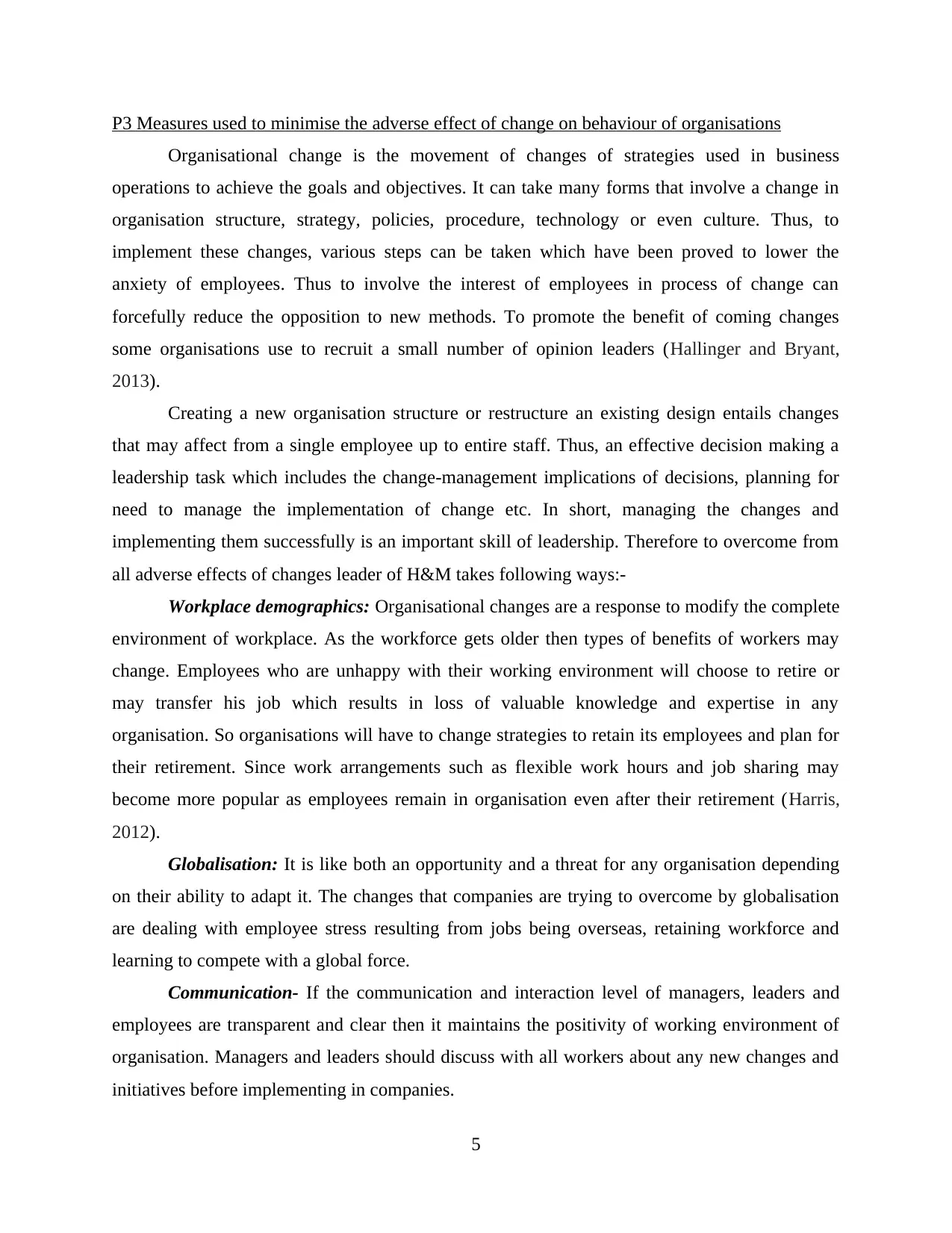
P3 Measures used to minimise the adverse effect of change on behaviour of organisations
Organisational change is the movement of changes of strategies used in business
operations to achieve the goals and objectives. It can take many forms that involve a change in
organisation structure, strategy, policies, procedure, technology or even culture. Thus, to
implement these changes, various steps can be taken which have been proved to lower the
anxiety of employees. Thus to involve the interest of employees in process of change can
forcefully reduce the opposition to new methods. To promote the benefit of coming changes
some organisations use to recruit a small number of opinion leaders (Hallinger and Bryant,
2013).
Creating a new organisation structure or restructure an existing design entails changes
that may affect from a single employee up to entire staff. Thus, an effective decision making a
leadership task which includes the change-management implications of decisions, planning for
need to manage the implementation of change etc. In short, managing the changes and
implementing them successfully is an important skill of leadership. Therefore to overcome from
all adverse effects of changes leader of H&M takes following ways:-
Workplace demographics: Organisational changes are a response to modify the complete
environment of workplace. As the workforce gets older then types of benefits of workers may
change. Employees who are unhappy with their working environment will choose to retire or
may transfer his job which results in loss of valuable knowledge and expertise in any
organisation. So organisations will have to change strategies to retain its employees and plan for
their retirement. Since work arrangements such as flexible work hours and job sharing may
become more popular as employees remain in organisation even after their retirement (Harris,
2012).
Globalisation: It is like both an opportunity and a threat for any organisation depending
on their ability to adapt it. The changes that companies are trying to overcome by globalisation
are dealing with employee stress resulting from jobs being overseas, retaining workforce and
learning to compete with a global force.
Communication- If the communication and interaction level of managers, leaders and
employees are transparent and clear then it maintains the positivity of working environment of
organisation. Managers and leaders should discuss with all workers about any new changes and
initiatives before implementing in companies.
5
Organisational change is the movement of changes of strategies used in business
operations to achieve the goals and objectives. It can take many forms that involve a change in
organisation structure, strategy, policies, procedure, technology or even culture. Thus, to
implement these changes, various steps can be taken which have been proved to lower the
anxiety of employees. Thus to involve the interest of employees in process of change can
forcefully reduce the opposition to new methods. To promote the benefit of coming changes
some organisations use to recruit a small number of opinion leaders (Hallinger and Bryant,
2013).
Creating a new organisation structure or restructure an existing design entails changes
that may affect from a single employee up to entire staff. Thus, an effective decision making a
leadership task which includes the change-management implications of decisions, planning for
need to manage the implementation of change etc. In short, managing the changes and
implementing them successfully is an important skill of leadership. Therefore to overcome from
all adverse effects of changes leader of H&M takes following ways:-
Workplace demographics: Organisational changes are a response to modify the complete
environment of workplace. As the workforce gets older then types of benefits of workers may
change. Employees who are unhappy with their working environment will choose to retire or
may transfer his job which results in loss of valuable knowledge and expertise in any
organisation. So organisations will have to change strategies to retain its employees and plan for
their retirement. Since work arrangements such as flexible work hours and job sharing may
become more popular as employees remain in organisation even after their retirement (Harris,
2012).
Globalisation: It is like both an opportunity and a threat for any organisation depending
on their ability to adapt it. The changes that companies are trying to overcome by globalisation
are dealing with employee stress resulting from jobs being overseas, retaining workforce and
learning to compete with a global force.
Communication- If the communication and interaction level of managers, leaders and
employees are transparent and clear then it maintains the positivity of working environment of
organisation. Managers and leaders should discuss with all workers about any new changes and
initiatives before implementing in companies.
5
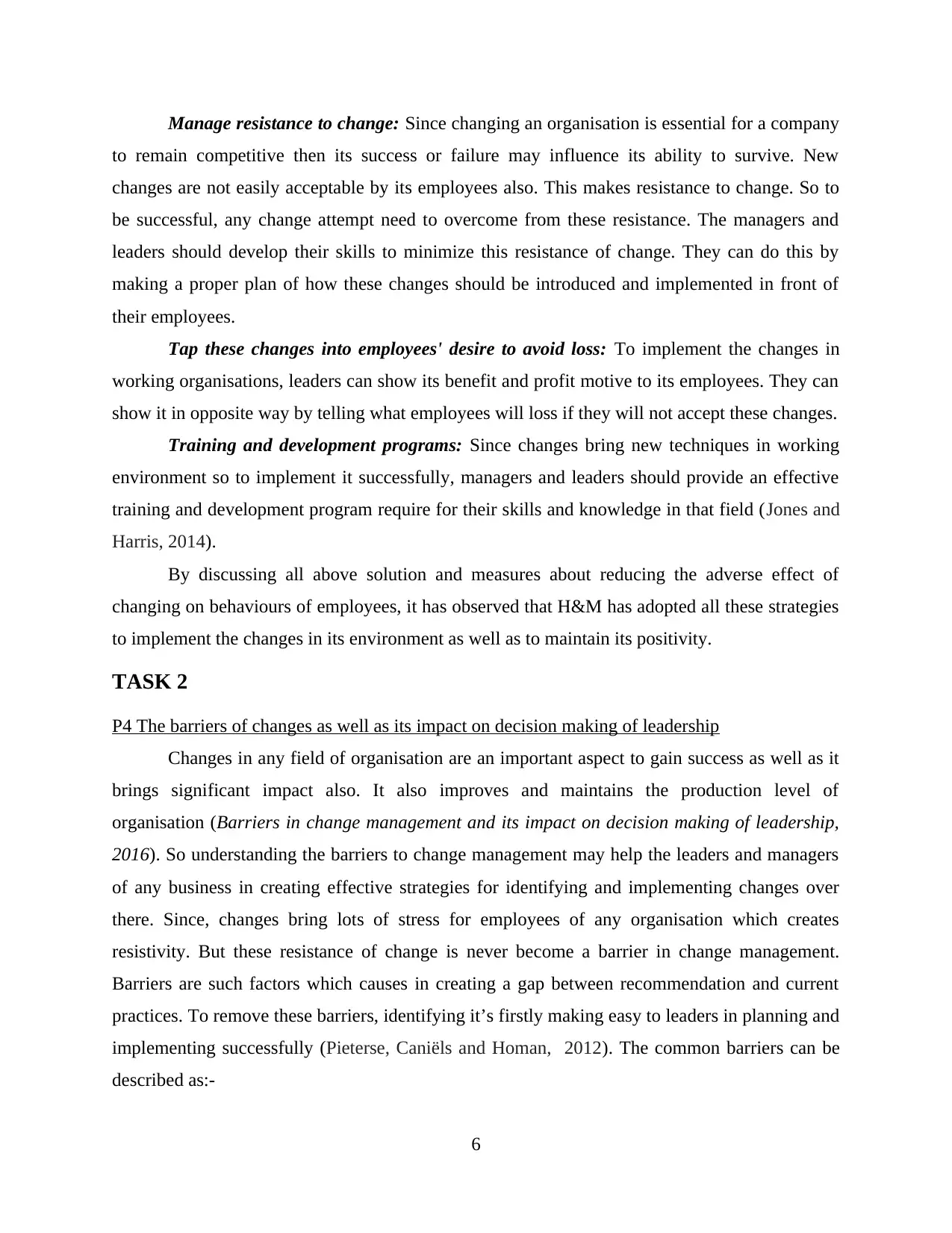
Manage resistance to change: Since changing an organisation is essential for a company
to remain competitive then its success or failure may influence its ability to survive. New
changes are not easily acceptable by its employees also. This makes resistance to change. So to
be successful, any change attempt need to overcome from these resistance. The managers and
leaders should develop their skills to minimize this resistance of change. They can do this by
making a proper plan of how these changes should be introduced and implemented in front of
their employees.
Tap these changes into employees' desire to avoid loss: To implement the changes in
working organisations, leaders can show its benefit and profit motive to its employees. They can
show it in opposite way by telling what employees will loss if they will not accept these changes.
Training and development programs: Since changes bring new techniques in working
environment so to implement it successfully, managers and leaders should provide an effective
training and development program require for their skills and knowledge in that field (Jones and
Harris, 2014).
By discussing all above solution and measures about reducing the adverse effect of
changing on behaviours of employees, it has observed that H&M has adopted all these strategies
to implement the changes in its environment as well as to maintain its positivity.
TASK 2
P4 The barriers of changes as well as its impact on decision making of leadership
Changes in any field of organisation are an important aspect to gain success as well as it
brings significant impact also. It also improves and maintains the production level of
organisation (Barriers in change management and its impact on decision making of leadership,
2016). So understanding the barriers to change management may help the leaders and managers
of any business in creating effective strategies for identifying and implementing changes over
there. Since, changes bring lots of stress for employees of any organisation which creates
resistivity. But these resistance of change is never become a barrier in change management.
Barriers are such factors which causes in creating a gap between recommendation and current
practices. To remove these barriers, identifying it’s firstly making easy to leaders in planning and
implementing successfully (Pieterse, Caniëls and Homan, 2012). The common barriers can be
described as:-
6
to remain competitive then its success or failure may influence its ability to survive. New
changes are not easily acceptable by its employees also. This makes resistance to change. So to
be successful, any change attempt need to overcome from these resistance. The managers and
leaders should develop their skills to minimize this resistance of change. They can do this by
making a proper plan of how these changes should be introduced and implemented in front of
their employees.
Tap these changes into employees' desire to avoid loss: To implement the changes in
working organisations, leaders can show its benefit and profit motive to its employees. They can
show it in opposite way by telling what employees will loss if they will not accept these changes.
Training and development programs: Since changes bring new techniques in working
environment so to implement it successfully, managers and leaders should provide an effective
training and development program require for their skills and knowledge in that field (Jones and
Harris, 2014).
By discussing all above solution and measures about reducing the adverse effect of
changing on behaviours of employees, it has observed that H&M has adopted all these strategies
to implement the changes in its environment as well as to maintain its positivity.
TASK 2
P4 The barriers of changes as well as its impact on decision making of leadership
Changes in any field of organisation are an important aspect to gain success as well as it
brings significant impact also. It also improves and maintains the production level of
organisation (Barriers in change management and its impact on decision making of leadership,
2016). So understanding the barriers to change management may help the leaders and managers
of any business in creating effective strategies for identifying and implementing changes over
there. Since, changes bring lots of stress for employees of any organisation which creates
resistivity. But these resistance of change is never become a barrier in change management.
Barriers are such factors which causes in creating a gap between recommendation and current
practices. To remove these barriers, identifying it’s firstly making easy to leaders in planning and
implementing successfully (Pieterse, Caniëls and Homan, 2012). The common barriers can be
described as:-
6
⊘ This is a preview!⊘
Do you want full access?
Subscribe today to unlock all pages.

Trusted by 1+ million students worldwide
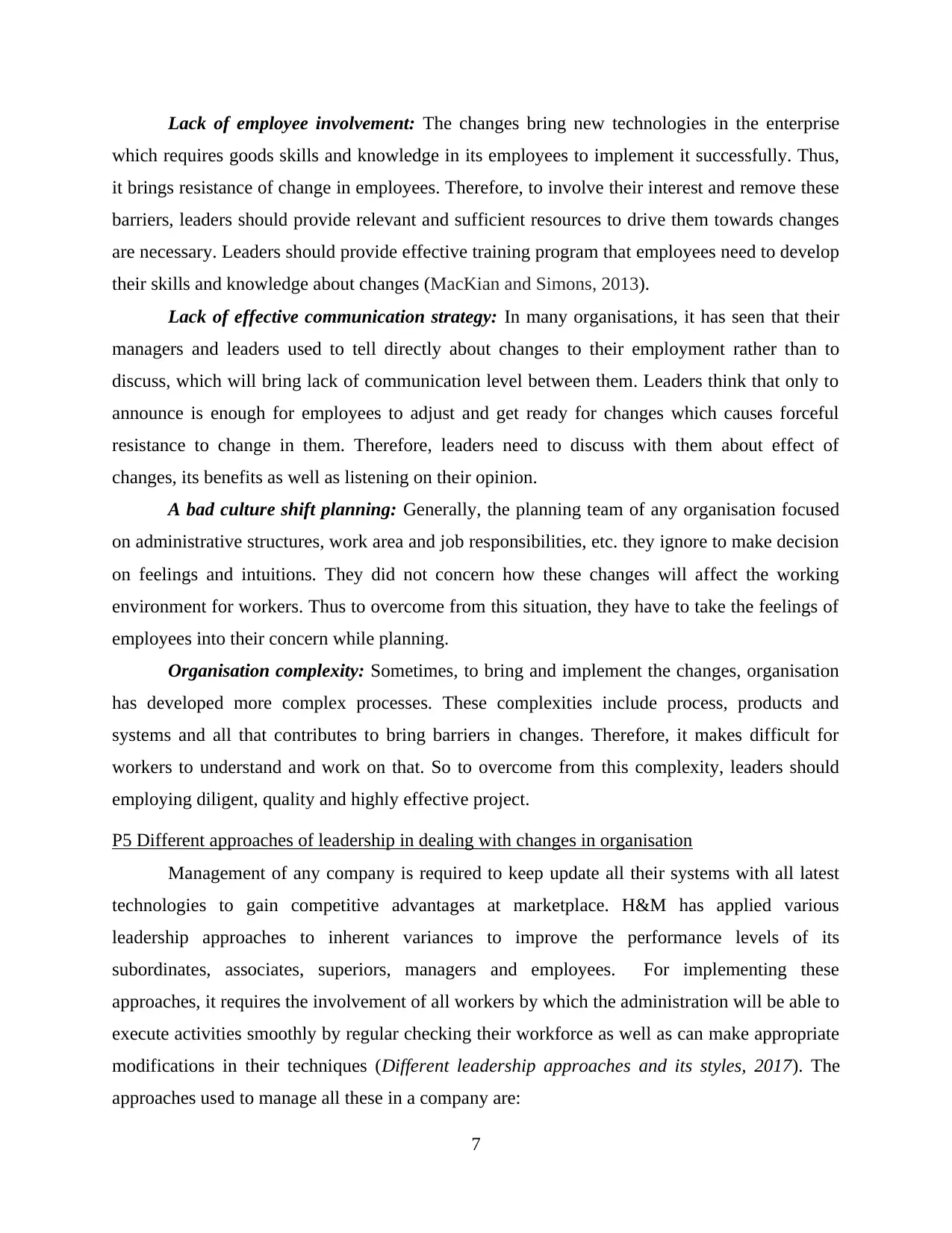
Lack of employee involvement: The changes bring new technologies in the enterprise
which requires goods skills and knowledge in its employees to implement it successfully. Thus,
it brings resistance of change in employees. Therefore, to involve their interest and remove these
barriers, leaders should provide relevant and sufficient resources to drive them towards changes
are necessary. Leaders should provide effective training program that employees need to develop
their skills and knowledge about changes (MacKian and Simons, 2013).
Lack of effective communication strategy: In many organisations, it has seen that their
managers and leaders used to tell directly about changes to their employment rather than to
discuss, which will bring lack of communication level between them. Leaders think that only to
announce is enough for employees to adjust and get ready for changes which causes forceful
resistance to change in them. Therefore, leaders need to discuss with them about effect of
changes, its benefits as well as listening on their opinion.
A bad culture shift planning: Generally, the planning team of any organisation focused
on administrative structures, work area and job responsibilities, etc. they ignore to make decision
on feelings and intuitions. They did not concern how these changes will affect the working
environment for workers. Thus to overcome from this situation, they have to take the feelings of
employees into their concern while planning.
Organisation complexity: Sometimes, to bring and implement the changes, organisation
has developed more complex processes. These complexities include process, products and
systems and all that contributes to bring barriers in changes. Therefore, it makes difficult for
workers to understand and work on that. So to overcome from this complexity, leaders should
employing diligent, quality and highly effective project.
P5 Different approaches of leadership in dealing with changes in organisation
Management of any company is required to keep update all their systems with all latest
technologies to gain competitive advantages at marketplace. H&M has applied various
leadership approaches to inherent variances to improve the performance levels of its
subordinates, associates, superiors, managers and employees. For implementing these
approaches, it requires the involvement of all workers by which the administration will be able to
execute activities smoothly by regular checking their workforce as well as can make appropriate
modifications in their techniques (Different leadership approaches and its styles, 2017). The
approaches used to manage all these in a company are:
7
which requires goods skills and knowledge in its employees to implement it successfully. Thus,
it brings resistance of change in employees. Therefore, to involve their interest and remove these
barriers, leaders should provide relevant and sufficient resources to drive them towards changes
are necessary. Leaders should provide effective training program that employees need to develop
their skills and knowledge about changes (MacKian and Simons, 2013).
Lack of effective communication strategy: In many organisations, it has seen that their
managers and leaders used to tell directly about changes to their employment rather than to
discuss, which will bring lack of communication level between them. Leaders think that only to
announce is enough for employees to adjust and get ready for changes which causes forceful
resistance to change in them. Therefore, leaders need to discuss with them about effect of
changes, its benefits as well as listening on their opinion.
A bad culture shift planning: Generally, the planning team of any organisation focused
on administrative structures, work area and job responsibilities, etc. they ignore to make decision
on feelings and intuitions. They did not concern how these changes will affect the working
environment for workers. Thus to overcome from this situation, they have to take the feelings of
employees into their concern while planning.
Organisation complexity: Sometimes, to bring and implement the changes, organisation
has developed more complex processes. These complexities include process, products and
systems and all that contributes to bring barriers in changes. Therefore, it makes difficult for
workers to understand and work on that. So to overcome from this complexity, leaders should
employing diligent, quality and highly effective project.
P5 Different approaches of leadership in dealing with changes in organisation
Management of any company is required to keep update all their systems with all latest
technologies to gain competitive advantages at marketplace. H&M has applied various
leadership approaches to inherent variances to improve the performance levels of its
subordinates, associates, superiors, managers and employees. For implementing these
approaches, it requires the involvement of all workers by which the administration will be able to
execute activities smoothly by regular checking their workforce as well as can make appropriate
modifications in their techniques (Different leadership approaches and its styles, 2017). The
approaches used to manage all these in a company are:
7
Paraphrase This Document
Need a fresh take? Get an instant paraphrase of this document with our AI Paraphraser
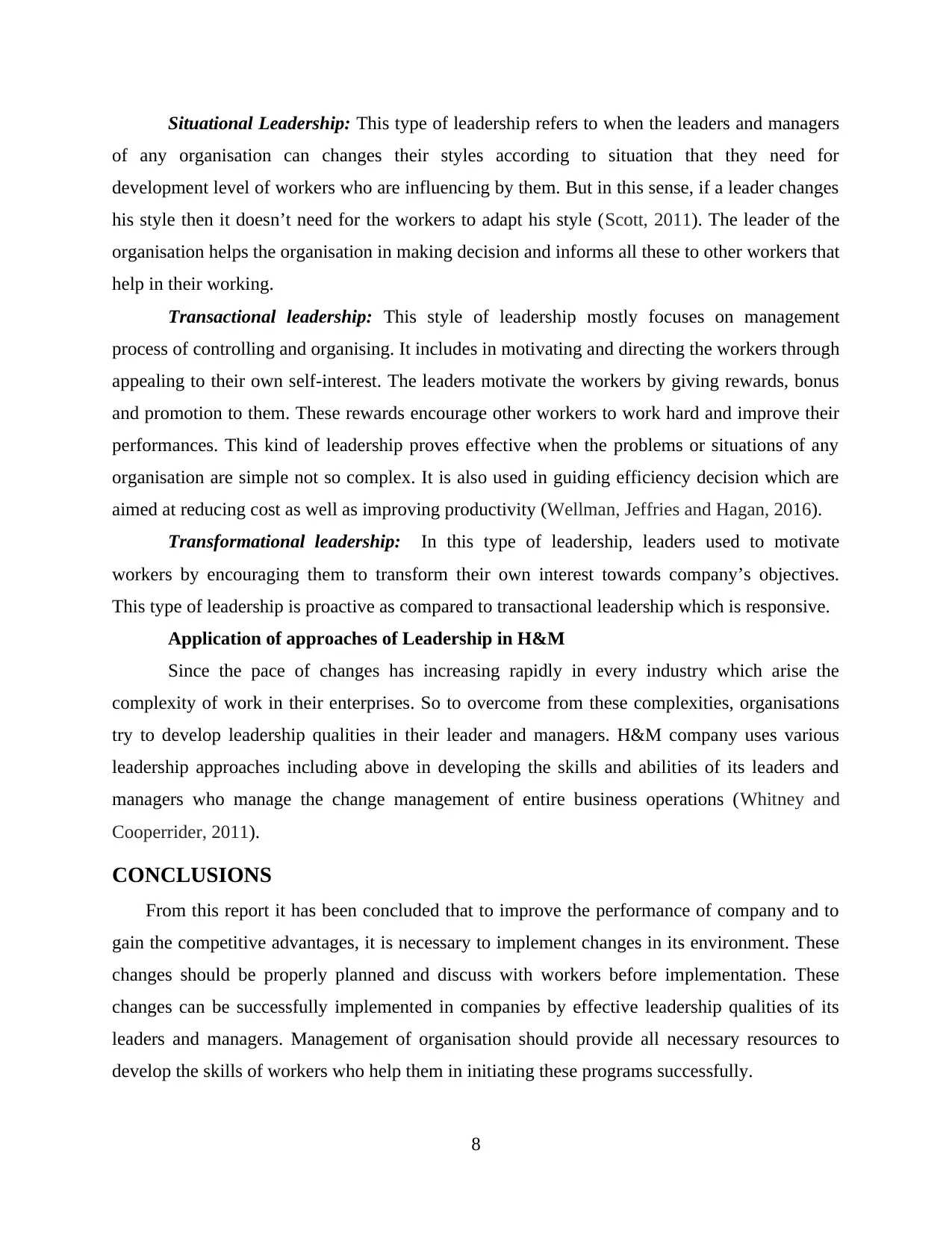
Situational Leadership: This type of leadership refers to when the leaders and managers
of any organisation can changes their styles according to situation that they need for
development level of workers who are influencing by them. But in this sense, if a leader changes
his style then it doesn’t need for the workers to adapt his style (Scott, 2011). The leader of the
organisation helps the organisation in making decision and informs all these to other workers that
help in their working.
Transactional leadership: This style of leadership mostly focuses on management
process of controlling and organising. It includes in motivating and directing the workers through
appealing to their own self-interest. The leaders motivate the workers by giving rewards, bonus
and promotion to them. These rewards encourage other workers to work hard and improve their
performances. This kind of leadership proves effective when the problems or situations of any
organisation are simple not so complex. It is also used in guiding efficiency decision which are
aimed at reducing cost as well as improving productivity (Wellman, Jeffries and Hagan, 2016).
Transformational leadership: In this type of leadership, leaders used to motivate
workers by encouraging them to transform their own interest towards company’s objectives.
This type of leadership is proactive as compared to transactional leadership which is responsive.
Application of approaches of Leadership in H&M
Since the pace of changes has increasing rapidly in every industry which arise the
complexity of work in their enterprises. So to overcome from these complexities, organisations
try to develop leadership qualities in their leader and managers. H&M company uses various
leadership approaches including above in developing the skills and abilities of its leaders and
managers who manage the change management of entire business operations (Whitney and
Cooperrider, 2011).
CONCLUSIONS
From this report it has been concluded that to improve the performance of company and to
gain the competitive advantages, it is necessary to implement changes in its environment. These
changes should be properly planned and discuss with workers before implementation. These
changes can be successfully implemented in companies by effective leadership qualities of its
leaders and managers. Management of organisation should provide all necessary resources to
develop the skills of workers who help them in initiating these programs successfully.
8
of any organisation can changes their styles according to situation that they need for
development level of workers who are influencing by them. But in this sense, if a leader changes
his style then it doesn’t need for the workers to adapt his style (Scott, 2011). The leader of the
organisation helps the organisation in making decision and informs all these to other workers that
help in their working.
Transactional leadership: This style of leadership mostly focuses on management
process of controlling and organising. It includes in motivating and directing the workers through
appealing to their own self-interest. The leaders motivate the workers by giving rewards, bonus
and promotion to them. These rewards encourage other workers to work hard and improve their
performances. This kind of leadership proves effective when the problems or situations of any
organisation are simple not so complex. It is also used in guiding efficiency decision which are
aimed at reducing cost as well as improving productivity (Wellman, Jeffries and Hagan, 2016).
Transformational leadership: In this type of leadership, leaders used to motivate
workers by encouraging them to transform their own interest towards company’s objectives.
This type of leadership is proactive as compared to transactional leadership which is responsive.
Application of approaches of Leadership in H&M
Since the pace of changes has increasing rapidly in every industry which arise the
complexity of work in their enterprises. So to overcome from these complexities, organisations
try to develop leadership qualities in their leader and managers. H&M company uses various
leadership approaches including above in developing the skills and abilities of its leaders and
managers who manage the change management of entire business operations (Whitney and
Cooperrider, 2011).
CONCLUSIONS
From this report it has been concluded that to improve the performance of company and to
gain the competitive advantages, it is necessary to implement changes in its environment. These
changes should be properly planned and discuss with workers before implementation. These
changes can be successfully implemented in companies by effective leadership qualities of its
leaders and managers. Management of organisation should provide all necessary resources to
develop the skills of workers who help them in initiating these programs successfully.
8

9
⊘ This is a preview!⊘
Do you want full access?
Subscribe today to unlock all pages.

Trusted by 1+ million students worldwide
1 out of 14
Related Documents
Your All-in-One AI-Powered Toolkit for Academic Success.
+13062052269
info@desklib.com
Available 24*7 on WhatsApp / Email
![[object Object]](/_next/static/media/star-bottom.7253800d.svg)
Unlock your academic potential
Copyright © 2020–2025 A2Z Services. All Rights Reserved. Developed and managed by ZUCOL.





